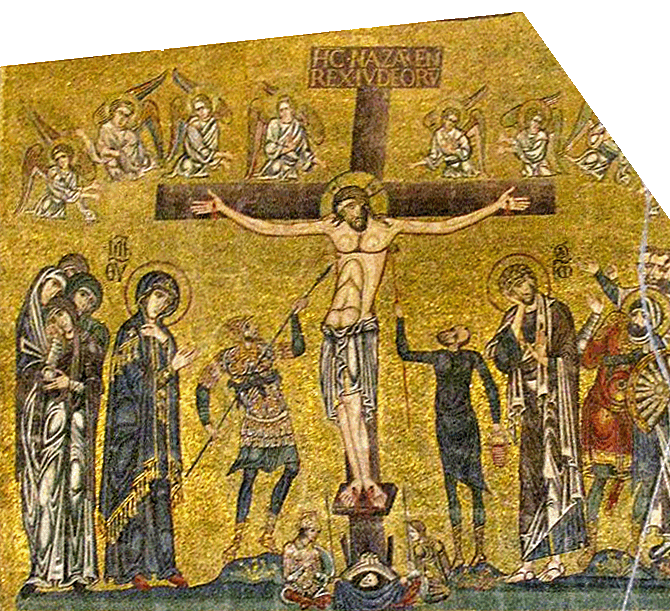The Crucifixion

Circa 1200
Mosaic
St. Mark's Basilica, Venice, Italy
This is an early example of a Crucifixion image that aims at inspiring pathos in the viewer. Above the crossbeam the usual sun and moon are replaced by angels who engage the viewer's eye while they point to the dying Christ with his closed eyes, jutting hip, and flowing blood. The priestly colobium of earlier works is replaced by a skirt that leaves him mostly naked.
At left, four disconsolate women accompany Mary, three in dark veils and one either bare-headed or wearing a light-colored veil. The latter is most likely St. Mary Magdalene. This same arrangement, always with the Magdalene behind the others, is used in the
Crucifixion
and
Deposition
frescos installed in Aquileia's basilica just a few decades earlier. They could have been the models for the present mosaic, or more likely the two artists both modeled the group on some Byzantine original. After the 12th century this way of arranging the women appears quite often in Byzantine Crucifixion icons.
On the far right the centurion and his men proclaim, "Indeed this was the son of God" (Matthew 27:54). The centurion's halo is another feature shared with the Aquileia frescos. It reflects the idea in the commentaries that the centurion represents the Church. The Glossa Ordinaria, for example, cites Tertullian: "The Church is signified in the faith of the centurion" (V, 462, my translation). Commentators collected in Aquinas's Catena Aurea concur in nearly identical language (Pusey, I, 965).
Left and right of the cross are Longinus with his spear and Stephaton with his bucket and sponge. The portrayal of Longinus indicates no awareness of the legend of his blindness. Jesus' blood simply flows from his side without coming anywhere near the soldier, whose eye seems to be in good order.
At the foot of the cross is Adam's skull, flanked by the men playing dice for Jesus' cloak.
Read more about images of The Crucifixion, Mary Magdalene, and Longinus.
Source: this page at Wikimedia Commons.